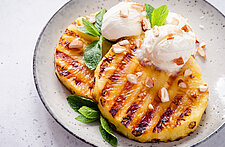Call it “Flour Power:” Milling, mentioned as a burgeoning trend at the 2015 StarChefs International Chefs Congress (ICC) (Click HERE for past post) was in full stride at the 2016 meeting.
The food cart focus of Day Two at the ICC, in particular, celebrated this trend, with chefs featuring the flexibility of fresh, local-milled grains. Dishes ranged from snacking to savory to sweets—with more than just quinoa, farro, and spelt on the menu. Less common ancient grains like amaranth, millet, and buckwheat also moved into the spotlight.
Jake Novick-Finder, Executive Chef of Brooklyn’s Gristmill, is one of those rallying behind the milling movement. “Our restaurant only serves whole and freshly milled grains, which are milled to order from small, local flour farms.” Novick-Finder, who served the restaurant’s Garlic Knots at the ICC (guests could choose between Everything Butter and Cacio De Pepe) also includes barley spaghetti carbonara, rye biscuits and gravy, and wood-fired pizzas made from their signature dough on his menu.
CLICK HERE to view our Top 11 Trends from Starchefs ICC!
“The farmer dictates our menu,” he adds. “We give the ego to the farmer.”
As to why Novick-Finder believes there’s a surge of ancient grain use? “A lot of our clientele is looking for more nutritious food and a lot of them are gluten-conscious,” he says. “Many ancient grains are gluten-free and they are more nutritious than refined grain products, and we source grains that are pesticide-free, which I think causes a lot of the digestive problems.”

Pastry Chef Melissa Denmark of Gracie’s in Providence, RI is also a milling fan. “Buckwheat is my favorite of the alternative wheat flours,” she explains.” It used to be this waste product. Now [because chefs are including buckwheat in dishes] it’s become a sustainable crop for farmers.”
And buckwheat isn’t just for soba noodles—or savory—anymore. Denmark’s Buckwheat Cruller with goat milk custard, blackberry compote, and honey-miso butterscotch proved the point whole-heartedly. “Buckwheat is great to use in pastry because it has this beautiful, unique flavor and aroma. One of my favorite things to work with is buckwheat honey. It’s so funky!”
CLICK HERE to subscribe to weekly trends and insights in food and beverage
The craft beer movement, which also benefited from relationships to brewery’s local farmers, has also inspired chefs to work with milled grains. “I’ve been home brewing since I was 19-years-old,” says John Little of Denver, CO. “Recently, I was milling for my next beer production, and I started thinking about the grains differently.”
The result? A Stout Gnocchi served with Little’s own short rib kielbasa, brussels sprout leaves, charred turnips, and dill crème fraîche. The dished proved chefs could transform grain flavor and play a supportive roll in a dish featuring multiple flavors. “In this dish, I roasted the grains before I milled them, and then used the final product to create this gnocchi,” he says. “The gnocchi adds this great char flavor to this traditional, Polish-style dish.”
Chef Steve Santana’s “Tamal en Cazuela” included fresh milled corn, white olotillo, blood sausage, and herb salad. “I am inspired by Mexican dishes,” says Santana, whose restaurant Tequiza in Miami, FL is known for its corn tortillas handmade from freshly ground corn. “I try to keep things traditional. We used our ground corn to make the tamale with the blood sausage inside. We fried the cake so it was crispy on the outside, but still soft on the inside.”
Santana went on to speak to the flexibility of milled grains when it comes to flavor. “The great thing about using milled grains is they can be a vessel for so many flavors,” he says. “I created this homemade hot sauce (ancho, chili pepper, Mexican oregano, pepper, garlic) to compliment the tamale, and it gives the whole dish this spicy kick.”

The dish was specifically created for the ICC, but Santana says it received such rave reviews, he may add it to his menu at Tequiza.
Jonathan Beno of NYC s Lincoln Ristorante added to the milling conversation on Day Three on the ICC Main Stage. He said he was inspired to try his own milling after reading what Dan Barber (of Blue Hill in Manhattan and Blue Hill at Stone Barns in Pocantico Hills, NY) talked about in his recent book. Paraphrasing Barber, Beno says: “Why do we give so much attention to ingredients we work with—where our eggs come from, where the chicken comes from—yet when it comes to flour, there’s that bin under the counter and we have no idea about its origin.”
It’s why he started milling his own pasta 10 months ago So far, his biggest successes have been using polenta, farro, spelt, rye and wheat berry though he has tried oat, spelt, quinoa and buckwheat.
And while he admits it’s impossible for them—with the small mill they have—to mill all their pasta and bread it’s a goal he’d eventually like to see. “Milling,” he says, “Is a lost tradition and one I’d like to see us get back to.”
CLICK HERE to see the Top Leading Edge Dishes from Starchefs ICC!





